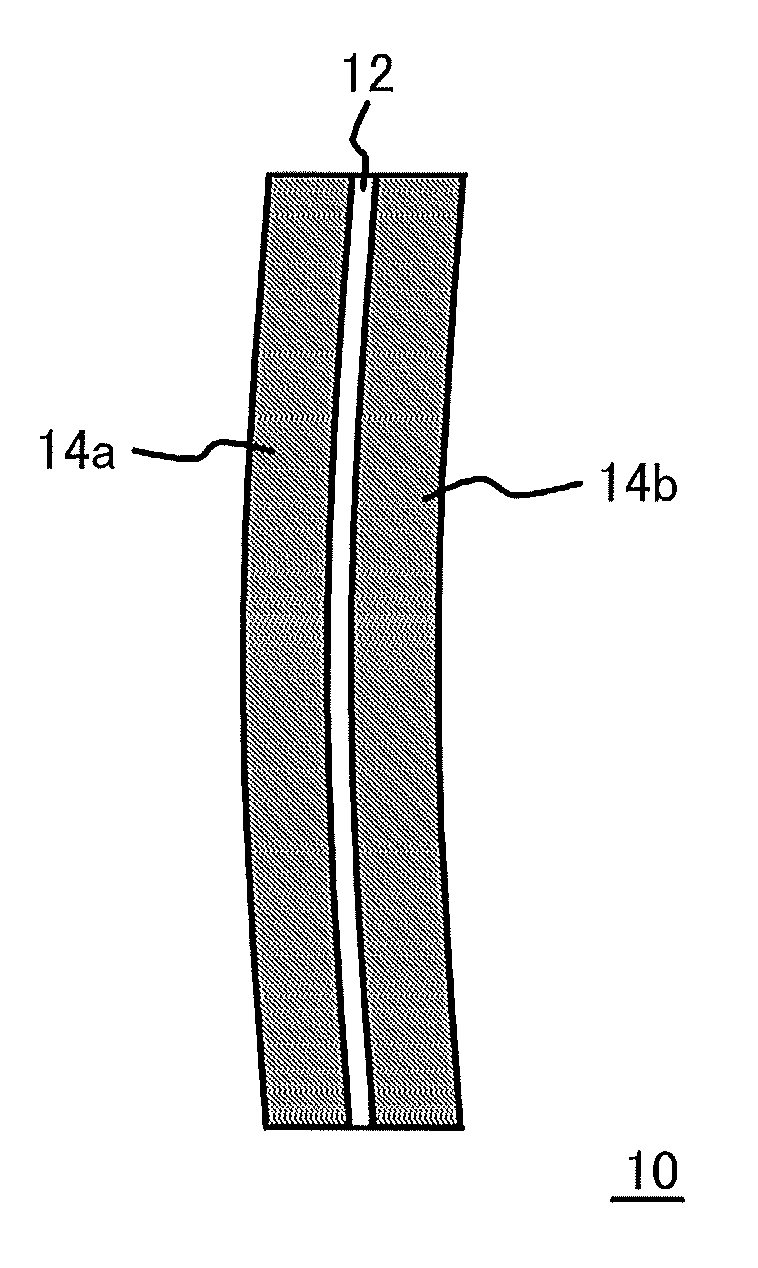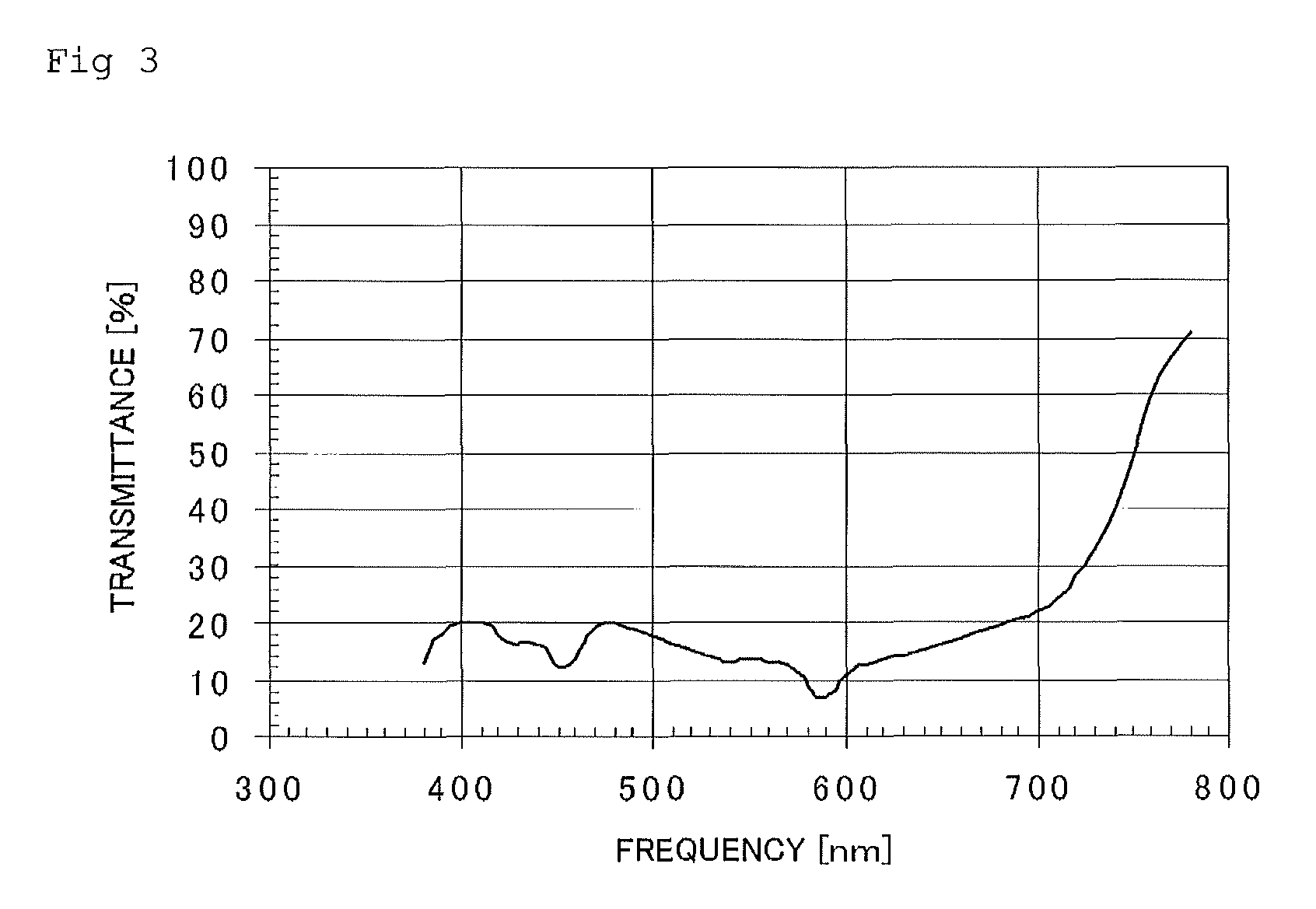Plastic polarized lens, method for producing the same, and polarized film
a technology of polarized polyvinyl alcohol and lens material, which is applied in the direction of polarizing elements, instruments, applications, etc., can solve the problems of deterioration, polarized film is liable to be peeled off from the lens material during a periphery polishing process, and polarized lens preparation using polarized polyvinyl alcohol film, etc., to achieve high contrast. the effect of property
- Summary
- Abstract
- Description
- Claims
- Application Information
AI Technical Summary
Benefits of technology
Problems solved by technology
Method used
Image
Examples
example 1
[0319]0.0150 parts by weight of organic coloring compound A, and suitable blending amounts of the dichroic dyes A to H were prepared to give a desired color tone, and mixed with 100 parts by weight of a polyethylene terephthalate resin. The resin made molten using a T die film molding machine was cast by T die and molded into a film, and the film was subjected to a 4-times stretching operation to obtain a polarized film having a thickness of 140 μm. The polarized film contained 134 ppm of the organic coloring compound A.
[0320]The absorbance of the obtained polarized film was measured using an absorbance measurement device, UV / VIS SPECTROMETER V-550, manufactured by JASCO Inc. The measurement results are shown in FIG. 3. As shown in FIG. 3, there was a peak of maximum absorption at 588 nm. In addition, the polarized film had polarization characteristics.
[0321]The glass transition temperature of the polyethylene terephthalate-made polarized film as obtained above, which was provided w...
example 2
[0323]The polyethylene terephthalate-made polarized film obtained above in Example 1 [glass transition temperature: 70.7° C.] (thickness 140 μm) was shaped in a curved shape of 2C (curve) at a shaping temperature of 120° C. by a heat pressing method. The polarized film was prepared by cutting the polarized film to match the mold size. This was inserted and installed inside the polarized lens casting mold (glass mold set −5D with a front surface of 2C and a rear surface of 6C) shown in FIG. 2.
[0324]On other hand, 50.6 parts by weight of m-xylylene diisocyanate, 49.4 parts by weight of a mixture of 4,8-dimercaptomethyl-1,11-dimercapto-3,6,9-trithiaundecane, 4,7-dimercaptomethyl-1,11-dimercapto-3,6,9-trithiaundecane and 5,7-dimercaptomethyl-1,11-dimercapto-3,6,9-trithiaundecane, 0.01 parts by weight of dibutyl tin dichloride as a curing promoting agent, 0.1 parts by weight of Zelec UN (registered trademark, manufactured by Stepan Company) as a mold releasing agent and 0.05 parts by wei...
example 3
[0339]The polyethylene terephthalate-made polarized film obtained above in Example 1 [glass transition temperature: 70.7° C.] (thickness 140 μm) was subjected to a heating treatment in an oven at 140° C. for 15 minutes in advance, and then shaped in a curved shape of 6C (curve) at a shaping temperature of 160° C. by a heat pressing method. The polarized film was cut to match the mold size, and then the surface and the back surface of the polarized film were irradiated with plasma for 20 seconds, respectively, using a surface modification device by irradiation with plasma (PS-601 SW type: manufactured by Wedge Co., Ltd.), washed with methanol, and then air-dried. This was inserted and installed inside the polarized lens casting mold (glass mold set with a front surface of 6C and a rear surface of 6C, center thickness: 12 mm). Further, in the same manner as in Example 2, the monomer mixture for injection was injected, warmed from 25° C. to 100° C. in an oven over 16 hours, and then ke...
PUM
| Property | Measurement | Unit |
|---|---|---|
| refractive index | aaaaa | aaaaa |
| refractive index | aaaaa | aaaaa |
| viscosity | aaaaa | aaaaa |
Abstract
Description
Claims
Application Information
 Login to View More
Login to View More - R&D
- Intellectual Property
- Life Sciences
- Materials
- Tech Scout
- Unparalleled Data Quality
- Higher Quality Content
- 60% Fewer Hallucinations
Browse by: Latest US Patents, China's latest patents, Technical Efficacy Thesaurus, Application Domain, Technology Topic, Popular Technical Reports.
© 2025 PatSnap. All rights reserved.Legal|Privacy policy|Modern Slavery Act Transparency Statement|Sitemap|About US| Contact US: help@patsnap.com



